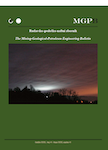Assessment of the risk of potable water supply in the area of amphibious military operation
DOI:
https://doi.org/10.17794/rgn.2019.2.8Keywords:
Military geography, military geology, military logistic, risk management, water supply intelligence, military historyAbstract
This paper proposes a method and a "tool" for assessment and management the risk of potable water supply in the amphibious military operation area through examples from military history. Amphibious landing is one of the most risky types of military operations, and the supply of military units with potable water in such operations represents a critical logistic function that may depend on the success or failure of a military operation. Potable water supply is a very important segment in the overall supply. Potable water is resources without soldier cannot endure long-term combat, for this are many examples in military history like is, for example, a battle of Hattin in 1187. The assessment and management of drinking water risk is an area of interest for military logistics and military geosciences. The water supply risk assessment matrix is a "tool" that can help military planners to realistically assess the risk, to determine the level of risk management and method how to control this risk.
Downloads
Published
How to Cite
Issue
Section
License
Copyright (c) 2019 authors and journal

This work is licensed under a Creative Commons Attribution 4.0 International License.
Creative Commons-BY
Authors who publish with this journal agree to the following terms:
In agreeing this form, you certify that:
- You read the ethical codex of the RGN zbornik available at journal web.
- You submitted work is your original work, and has not previously been published and does not include any form of plagiarism.
- You own copyright in the submitted work, and are therefore permitted to assign the licence to publish to RGN zbornik.
- Your submitted work contains no violation of any existing copyright or other third party right or any material of an obscene, libellous or otherwise unlawful nature.
- You have obtained permission for and acknowledged the source of any illustrations, diagrams or other material included in the work of which you are not the copyright owner.
- You have taken due care to ensure the accuracy of the work, and that, to the best of your knowledge, there are no false statements made within it.
- All co-authors of this submitted work are aware of, and in agreement with, the terms of this licence and that the submitted manuscript has been approved by these authors.
Publication licence
You retain copyright in your submitted work, according to journal license policy (CC-BY). By signing this form you agree that RGN zbornik may publish it under the publication licence. In summary the licence allows the following:
Anyone is free:
- To copy, distribute, display, and perform the work.
- To make derivative works.
Under the following conditions:
- The original author must always be given credit.
- The work may not be used for commercial purposes.
- If the work is altered, transformed, or built upon, the resulting work may only be distributed under a licence identical to this one.
Exceptions to the licence
In addition to publishing the work printed under the above licence, RGN zbornik will also enable the work to be visible online.
The journal editorial can change the licence rules anytime but it cannot retroactively restrict author(s) rights.


